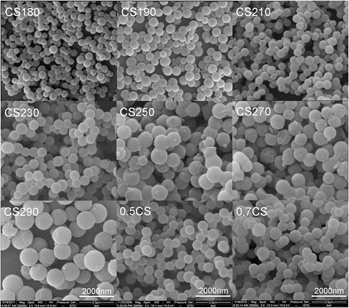Crossref Citations
This article has been cited by the following publications. This list is generated based on data provided by
Crossref.
Zhao, Y.
Li, W.
Zhao, X.
Wang, D. P.
and
Liu, S. X.
2013.
Carbon spheres obtained via citric acid catalysed hydrothermal carbonisation of cellulose.
Materials Research Innovations,
Vol. 17,
Issue. 7,
p.
546.
Wu, Qiong
Li, Wei
Tan, Jia
and
Liu, Shouxin
2014.
Flexible cage-like carbon spheres with ordered mesoporous structures prepared via a soft-template/hydrothermal process from carboxymethylcellulose.
RSC Adv.,
Vol. 4,
Issue. 106,
p.
61518.
Gong, Yutong
Xie, Lei
Li, Haoran
and
Wang, Yong
2014.
Sustainable and scalable production of monodisperse and highly uniform colloidal carbonaceous spheres using sodium polyacrylate as the dispersant.
Chem. Commun.,
Vol. 50,
Issue. 84,
p.
12633.
Wu, Qiong
Li, Wei
Dai, Linlin
Wu, Yanjiao
and
Liu, Shouxin
2014.
Adsorbents with sustainable CO2 capture capacity prepared from carboxymethylcellulose.
Journal of Materials Research,
Vol. 29,
Issue. 14,
p.
1565.
Dubey, Shashi Prabha
Dwivedi, Amarendra Dhar
Sillanpää, Mika
Kwon, Young-Nam
and
Lee, Changha
2014.
Single-step green synthesis of imine-functionalized carbon spheres and their application in uranium removal from aqueous solution.
RSC Adv.,
Vol. 4,
Issue. 86,
p.
46114.
Dubey, Shashi Prabha
Dwivedi, Amarendra Dhar
Kim, In-Chul
Sillanpaa, Mika
Kwon, Young-Nam
and
Lee, Changha
2014.
Synthesis of graphene–carbon sphere hybrid aerogel with silver nanoparticles and its catalytic and adsorption applications.
Chemical Engineering Journal,
Vol. 244,
Issue. ,
p.
160.
Gong, Yutong
Wang, Haiyan
Wei, Zhongzhe
Xie, Lei
and
Wang, Yong
2014.
An Efficient Way To Introduce Hierarchical Structure into Biomass-Based Hydrothermal Carbonaceous Materials.
ACS Sustainable Chemistry & Engineering,
Vol. 2,
Issue. 10,
p.
2435.
Zhao, Xin
Li, Wei
Zhang, Shuangshuang
Liu, Lihua
and
Liu, Shouxin
2015.
Hierarchically tunable porous carbon spheres derived from larch sawdust and application for efficiently removing Cr (Ⅲ) and Pb (Ⅱ).
Materials Chemistry and Physics,
Vol. 155,
Issue. ,
p.
52.
Xiang, Jiayuan
Chen, Zhewei
and
Wang, Jianming
2015.
Octahedral core–shell cuprous oxide/carbon with enhanced electrochemical activity and stability as anode for lithium ion batteries.
Materials Research Bulletin,
Vol. 70,
Issue. ,
p.
456.
Wu, Qiong
Li, Wei
Wu, Peng
Li, Jian
Liu, Shouxin
Jin, Chunde
and
Zhan, Xianxu
2015.
Effect of reaction temperature on properties of carbon nanodots and their visible-light photocatalytic degradation of tetracyline.
RSC Advances,
Vol. 5,
Issue. 92,
p.
75711.
Xia, Xinhui
Zhang, Yongqi
Fan, Zhanxi
Chao, Dongliang
Xiong, Qinqin
Tu, Jiangping
Zhang, Hua
and
Fan, Hong Jin
2015.
Novel Metal@Carbon Spheres Core–Shell Arrays by Controlled Self‐Assembly of Carbon Nanospheres: A Stable and Flexible Supercapacitor Electrode.
Advanced Energy Materials,
Vol. 5,
Issue. 6,
LI, Ying-fen
GAN, Wei-ping
ZHOU, Jian
LU, Zhi-qiang
YANG, Chao
and
GE, Tian-tian
2015.
Hydrothermal synthesis of silver nanoparticles in Arabic gum aqueous solutions.
Transactions of Nonferrous Metals Society of China,
Vol. 25,
Issue. 6,
p.
2081.
Wu, Qiong
Li, Wei
Wu, Yanjiao
Zong, Guanggong
and
Liu, Shouxin
2015.
Effect of reaction time on structure of ordered mesoporous carbon microspheres prepared from carboxymethyl cellulose by soft-template method.
Industrial Crops and Products,
Vol. 76,
Issue. ,
p.
866.
Mwenya, Trevor
Fan, Huiyang
Dai, Han
and
Li, Meicheng
2016.
The Detailed Evolution of Carbon Spheres by Hydrothermal Method.
International Journal of Photoenergy,
Vol. 2016,
Issue. ,
p.
1.
Lv, Lin
Xu, Kui
Wang, Chundong
Wan, Houzhao
Ruan, Yunjun
Liu, Jia
Zou, Rujia
Miao, Ling
Ostrikov, Kostya (Ken)
Lan, Yucheng
and
Jiang, Jianjun
2016.
Intercalation of Glucose in NiMn-Layered Double Hydroxide Nanosheets: an Effective Path Way towards Battery-type Electrodes with Enhanced Performance.
Electrochimica Acta,
Vol. 216,
Issue. ,
p.
35.
Wassner, Maximilian
Eckardt, Markus
Gebauer, Christian
Hüsing, Nicola
and
Behm, R. Jürgen
2016.
Spherical Core–Shell Titanium (Oxy)nitride@Nitrided Carbon Composites as Catalysts for the Oxygen Reduction Reaction: Synthesis and Electrocatalytic Performance.
ChemElectroChem,
Vol. 3,
Issue. 10,
p.
1641.
Hao, Zhi-Qiang
Cao, Jing-Pei
Wu, Yan
Zhao, Xiao-Yan
Zhuang, Qi-Qi
Wang, Xing-Yong
and
Wei, Xian-Yong
2017.
Preparation of porous carbon sphere from waste sugar solution for electric double-layer capacitor.
Journal of Power Sources,
Vol. 361,
Issue. ,
p.
249.
Xu, Shunjian
Liu, Can
Ye, Feng
Guo, Yajie
and
Wiezorek, Jörg
2017.
Alkali-assisted hydrothermal route to control submicron-sized nanoporous carbon spheres with uniform distribution.
Colloids and Surfaces A: Physicochemical and Engineering Aspects,
Vol. 515,
Issue. ,
p.
1.
Sun, Jixian
Feng, Bo
Hu, Shujuan
Qin, Xiaohong
and
Zhang, Yue
2017.
Controlled synthesis of core-shell, yolk-shell and hollow spheres C@La 2 Zr 2 O 7 via the combination of hard templating and co-precipitation method.
Ceramics International,
Vol. 43,
Issue. 8,
p.
5941.
Zhou, Hai
Kang, Min
Qin, Biao
Zhao, Ning
Wu, Dong
Lv, Baoliang
and
Wang, Qingjie
2018.
Glucose-mediated template-free synthesis of hollow CuO microspheres.
RSC Advances,
Vol. 8,
Issue. 26,
p.
14157.



